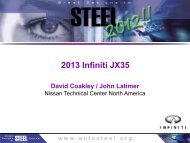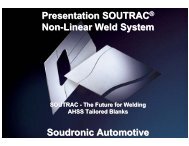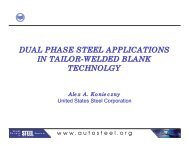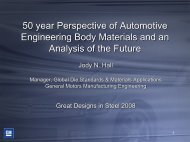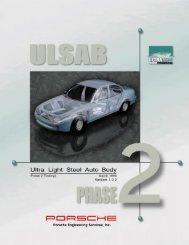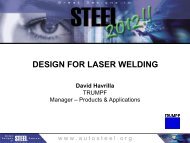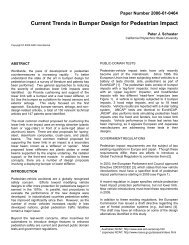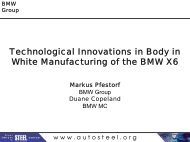UltraLight Steel Auto Body - Final Report - American Iron & Steel ...
UltraLight Steel Auto Body - Final Report - American Iron & Steel ...
UltraLight Steel Auto Body - Final Report - American Iron & Steel ...
You also want an ePaper? Increase the reach of your titles
YUMPU automatically turns print PDFs into web optimized ePapers that Google loves.
34<br />
AMS offset simulation behavior<br />
TIME (MS) EVENTS<br />
12 initial folding of longitudinal left hand side<br />
16 initial folding of subframe<br />
18 1st buckling of upper rails in front of shock tower<br />
36 wheels left hand side contact barrier<br />
40 engine contacts barrier; start of vehicle rotation<br />
around Z axis<br />
44 subframe front totally deformed; left hand<br />
longitudinal rail moves rearward, causing<br />
deformation in front floor; buckling of longitudinal<br />
rail in area of shock tower<br />
48 2nd buckling of upper rails left hand side behind<br />
shock tower<br />
52 buckling of rear end of subframe at fixture on<br />
extension longitudinals<br />
60 buckling of brace cowl to shock tower left hand<br />
side; engine hits steering gear<br />
68 gearbox mounting contacts brake booster<br />
70 wheel left hand side contacts hinge pillar<br />
88 maximum dynamic deformation<br />
This analysis shows good progressive crush on the barrier side<br />
(left), as well as crush on the right, indicating transfer of load to<br />
the right side of the structure. This transfer means that the barrier<br />
side is not relied upon solely to manage the crash event.<br />
This transfer also contributes to the preservation of the occupant<br />
compartment. The intrusion of 146 mm into the footwell is minimal<br />
given the severity of this event.<br />
The initial, early peak shown in the pulse graph should trigger<br />
airbag systems.<br />
35 MPH REAR MOVING BARRIER (FMVSS 301)<br />
The conditions for rear impact analysis are based on United<br />
States Rear Moving Barrier test FMVSS 301. The test specifically<br />
addresses fuel system integrity during rear impact. <strong>Auto</strong>motive<br />
companies also specify goals for structural integrity and<br />
passenger compartment volume.<br />
The impacting barrier is designed to represent a rigid body with a<br />
mass of 1830 kg that contacts the vehicle at zero degrees relative<br />
to the vehicle longitudinal axis. FMVSS 301 specifies the velocity<br />
of the rear moving barrier to be 30 mph at the time of impact.<br />
ULSAB ran its analysis at a velocity of 35 mph, which represents<br />
36 percent more kinetic energy.<br />
ULSAB <strong>Final</strong> <strong>Report</strong>



